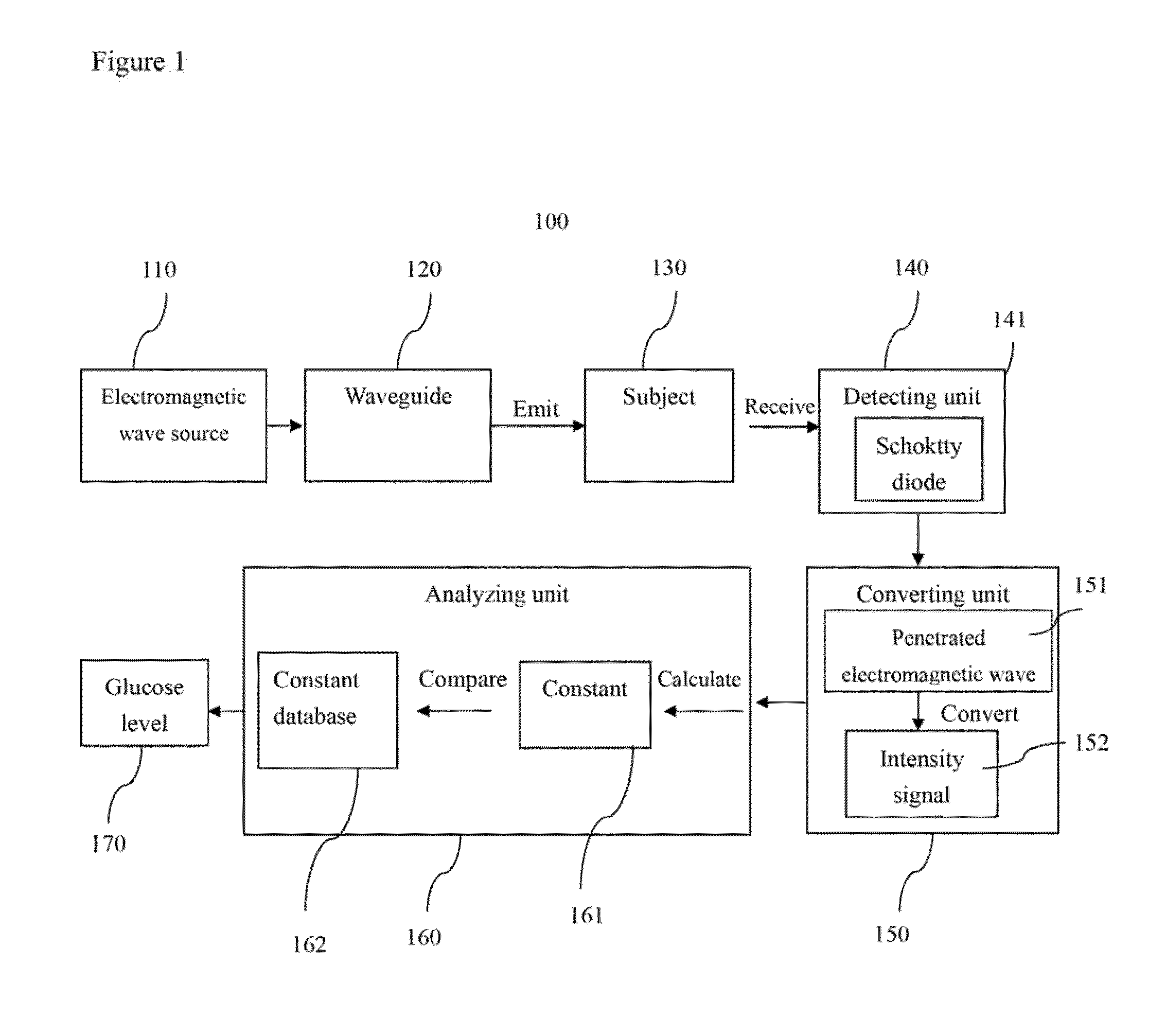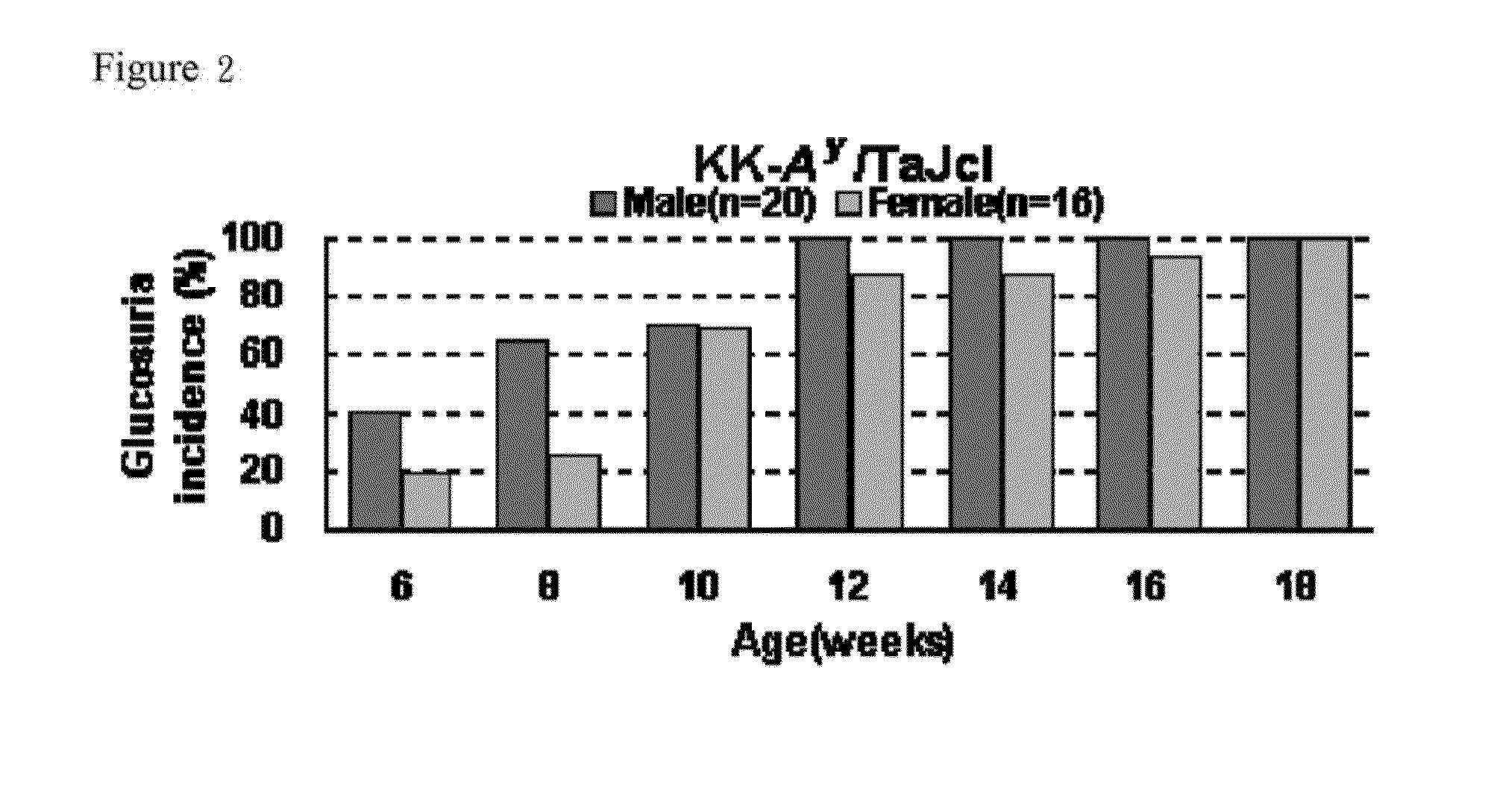Method and device for detecting a blood glucose level using a electromagnetic wave
a technology of electromagnetic wave and blood glucose level, which is applied in the field of noninvasive detection of blood glucose level, can solve the problems of extra payment, impose a tremendous burden on the individual with diabetes and the health care system, and the above techniques still have some limitations or disadvantages for measuring
- Summary
- Abstract
- Description
- Claims
- Application Information
AI Technical Summary
Benefits of technology
Problems solved by technology
Method used
Image
Examples
example 1
[0054]The present invention used 4˜7-week-old BALB / cByJNarl mouse (purchased from National Laboratory Animal Center in Taiwan) as a control model and used 4˜7-week-old KK-Ay / TaJcl mouse (purchased from CLEA Japan, Inc) as a type-2 diabetes model, which the blood glucose level raised during ageing, as shown in FIG. 2. The ear thickness of the mouse described above was 350 μm. The mouse was individually raised in a separated cage, and starved 8 hours before the experiment. Before experiment, the mouse was anesthetized using ketamine-xylazin (50 mg+15 mg / kg) by i.p. injection.
example 2
Blood Glucose Detecting Device
[0055]In this example, a device 300, as shown in FIG. 3, used a CW Gunn oscillator module 301 as a electromagnetic wave source, a parabolic mirror 302 for focusing and transmitting the electromagnetic wave from the source through a PE film 303 and to a waveguide unit 304. The waveguide unit 304 adopted a highly flexible THz sub-wavelength polyethylene (PE) fiber with a diameter of 240 μm, a length of 33 cm and a substantially low attenuation constant (5×10−3 cm−1). To improve the spatial resolution, behind the fiber output end, a bull's-eye metallic spatial filter with a subwavelength aperture (diameter of 200 μm) 305 was intergraded to achieve both a high transmission power (10-fold higher than transmission through a single bare aperture of the same size) and near-field spatial resolution (240 μm<λ / 4) beyond the diffraction limit.
[0056]The measurement frequency range of electromagnetic wave in this example was about 320˜420 GHz. 340 GHz was selected as...
example 3
Blood Glucose Detecting Device
[0062]In the present example, a device 400 (FIG. 8) used a CW Gunn oscillator module 401 as a electromagnetic wave source, and a parabolic mirror 402 for focusing and transmitting the electromagnetic wave from the source to a waveguide unit 403. The waveguide unit adopted a THz glass waveguide with an inner-diameter of 9 mm, an outer-diameter of 13 mm, a thickness of 2 mm and a length of 30 cm, wherein the glass waveguide had a substantially low attenuation constant (2×10−2 cm−1 @340 GHz). To improve the spatial resolution, a 300 um×700 um aperture was set in front of a Schoktty diode in a detecting unit 405.
[0063]The measurement frequency range of the electromagnetic wave in this example was about 320˜420 GHz. 340 GHz was selected as a working frequency. The electromagnetic wave power on the surface of a subject 404, such as a mouse, was about 1 mW. A room-temperature-operated Schottky diode detector (Virginia Diode, Inc, model WR-2.8, response time 30...
PUM
 Login to View More
Login to View More Abstract
Description
Claims
Application Information
 Login to View More
Login to View More - R&D
- Intellectual Property
- Life Sciences
- Materials
- Tech Scout
- Unparalleled Data Quality
- Higher Quality Content
- 60% Fewer Hallucinations
Browse by: Latest US Patents, China's latest patents, Technical Efficacy Thesaurus, Application Domain, Technology Topic, Popular Technical Reports.
© 2025 PatSnap. All rights reserved.Legal|Privacy policy|Modern Slavery Act Transparency Statement|Sitemap|About US| Contact US: help@patsnap.com



